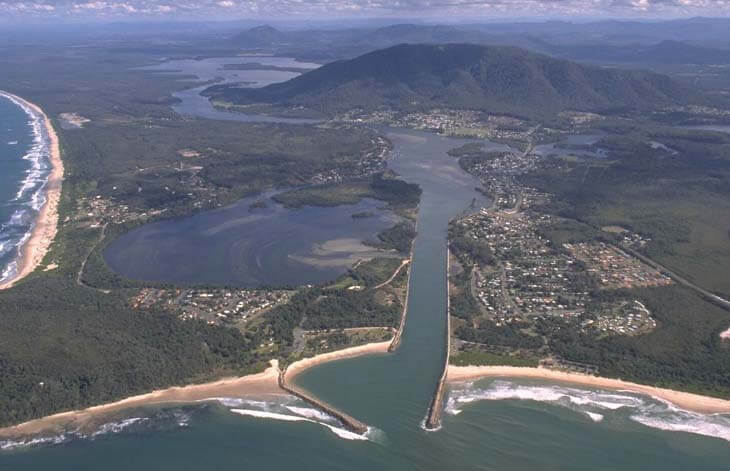Camden Haven River is situated on the mid-north coast of New South Wales. This estuary encompasses Queens Lake and Watson Taylors Lake, and is classed as a coastal lake. The extensively trained entrance is located between North Haven and Camden Head and remains permanently open to the sea.
The dynamic network of lakes, creeks and interconnecting channels associated with the river supports a rich and biodiverse area of high ecological and recreational value.
Water quality report card
As part of our water quality monitoring program we assess the water quality and ecosystem health of an estuary using a range of relevant indicators. We sample a subset of the estuaries located between the Queensland border and Taree every 3 years. The most recent sampling in the Camden Haven River was completed over the 2021–22 summer, when 2 sites were sampled on a monthly basis.
This report card represents 2 water quality indicators that we routinely measure: the amount of algae present and water clarity. Low levels of these 2 indicators equate with good water quality.
Algae
Water clarity
Overall grade
The report card shows the condition of the estuary was good with:
- algae abundance graded excellent (A)
- water clarity graded fair (C)
- overall estuary health graded good (B).
Grades for algae, water clarity and overall are represented as:
- A – excellent
- B – good
- C – fair
- D – poor
- E – very poor.
Go to estuary report cards to find out what each grade means, read our sampling, data analysis and reporting protocols, and find out how we calculate these grades.
Port Macquarie Hastings Council, in collaboration with the University of New England’s EcoHealth program, has carried out detailed ecosystem health monitoring in the Camden Haven River. The results of the monitoring program, including a detailed water quality report card, are available on the Port Macquarie Hastings Council website.
We have monitored water quality in Camden Haven River since 2009. This table shows the water quality grades for this estuary over that time.
| Year | Algae | Water clarity | Overall grade |
|---|---|---|---|
| 2009–10 | A | C | B |
Physical characteristics
| Estuary type | Lake |
|---|---|
| Latitude | –31.64 (ºS) |
| Longitude | 152.84 (ºE) |
| Catchment area | 589 km2 |
| Estuary area | 32.2 km2 |
| Estuary volume | 113,802.1 ML |
| Average depth | 3.6 m |
Tidal exchange volume
Tidal exchange volume or tidal prism data is available for this estuary. This tidal prism was measured in 1997.
| Tide state | Flow (ML) | Local tidal range (m) | Sydney Harbour tidal range (m) |
|---|---|---|---|
| Ebb flow | 7560 | 1.24 | 1.7 |
| Flood flow | 7750 | 1.27 | 1.71 |
Notes: km2 = square kilometres; m = metres; m3 = cubic metres; ML = megalitres.
Land use
The catchment of the Camden Haven River is moderately disturbed. Forested areas make up around three-quarters of the total catchment area. Much of the upper catchment remains forested, as well as parts of the coastal plain and a couple isolated mountains (within Middle Brother and Dooragan national parks). The coastal plain is interspersed with some urban areas and cleared areas for grazing and rural residence.
Camden Haven web cam
The Camden Haven bar crossing web camera provides real-time video of conditions within the river entrance immediately offshore to help with bar crossings and boat safety.
National and marine parks
- Crowdy Bay National Park is the largest conservation area in this catchment.
- This estuary does not flow into a marine park.
Community involvement
Camden Haven Landcare Group is one of the oldest active bushcare groups in the region and hosts twice-monthly working bees around the Camden Haven are. The group is open to volunteers interested to get involved.

Aerial view of Camden Haven River
Seafood harvest area status
The NSW Food Authority website lists the current status of oyster/shellfish harvest areas.
Local government management
Local councils manage estuaries within their area unless the estuary is attached to a marine park. Port Macquarie Hastings Council manages this estuary.
Threatened species
This estuary and its catchment provides habitat for the threatened glossy black-cockatoo.
Read more about the biodiversity in our estuaries.